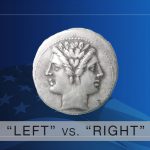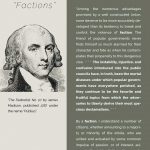Last Updated on November 3, 2021 by Constitutional Militia
No one who peruses even the Establishment’s pet media, let alone alternative sources of information, can remain unaware of the political maneuvers now on-going in aid of creating a so-called “North American Union” composed of the United States, Canada, and Mexico. Yet notwithstanding this publicity, conspicuous by its absence has been a detailed answer to the question: Exactly where in the Constitution lurks any power for the General Government, or the States, or both together, somehow to “merge” the United States, Canada, and Mexico into a single super-national entity?
To answer this question requires reversion to fundamental principles.
First, as its very title attests, the purpose of the Declaration of Independence was to claim and to justify Americans’ national independence. Not, however, simply as a matter of fact, but also and especially as a matter of law. The Declaration came into being when “it [became] necessary for one people to dissolve the political bonds which have connected them with another, and to assume among the powers of the earth, the separate and equal station to which the Laws of Nature and of Nature’s God entitle them.” And the Declaration asserted “That these United Colonies are, and of Right ought to be FREE AND INDEPENDENT STATES; * * * and that as Free and Independent States, they have full Power to levy War, conclude Peace, contract Alliances, establish Commerce, and to do all other Acts and Things which Independent States may of right do.” For Americans “to dissolve * * * political bonds” and “to assume among the powers of the earth, the separate and equal station to which the Laws of Nature and of Nature’s God entitle them” were not simply historical events with no moral or legal components, but acts that invoked and relied upon the highest legal authority, and entailed profound legal consequences.
Second, WE THE PEOPLE who composed the “Free and Independent States” then entered into the Constitution, not to repudiate or relegate to the dustbin of history either the fact of national independence that the Declaration announced or the principles of law that the Declaration embodied, but (as the Preamble to the Constitution states) in order “to form a more perfect Union” amongst themselves. That is, to secure the fact of independence and make the principles upon which it rested even more effective in practice than they had been theretofore.
Third, the legitimacy of the Constitution depends upon the Declaration of Independence; and therefore the Constitution’s powers cannot contradict the Declaration’s principles. For, were the Declaration not an actual law both prior in time and superior in authority to the Constitution, and the source of WE THE PEOPLE’S authority to enact the Constitution, the Constitution itself would not be valid. After all, before they could enact their own laws, binding on anyone, including themselves, Americans had to win legal independence from Great Britain. They secured that independence only under the aegis of the Declaration. Therefore, they could enact only such subsequent laws as were entirely consistent with the principles the Declaration set forth.
Fourth, the “more perfect Union” of the Constitution in no way rejected the sovereign status of “the several States” incorporated within the Constitution’s federal system. Rather, it modified that status only insofar as WE THE PEOPLE, through the Constitution, explicitly limited some of the powers of the States in ways favorable to the Union. (In particular, see Article I, Section 10, Clauses 1 through 3, and Article VI, Clause 2.) And out of the limitations on the sovereignties of the States, the Constitution created a sovereign status for the Union as a whole among the nations of the world. (In particular, see Article I, Section 8, Clauses 3, 4, 11, 12, and 13; Article I, Section 9, Clause 8; Article I, Section 10, Clauses 1 and 3; and Article II, Section 2, Clause 2.)
Thus, the Constitution was not a repudiation of national independence, but a transferral of some of the powers of “Free and Independent States” from the individual States to the “more perfect Union” of them all, and thereby a perfection of national independence. For it enabled all of the States together to “establish Justice, insure domestic Tranquility, provide for the common defence, promote the general Welfare, and secure the Blessings of Liberty” in ways more effective than any of the States could have put into operation individually.
Fifth, although in theory wholly “FREE AND INDEPENDENT STATES” could merge with foreign states, in practice under the Constitution this is not possible. Perforce of the Constitution, WE THE PEOPLE have caused the States to surrender their primordial ability to do so, and have delegated no competence to the General Government in that particular.
(a) The most basic rule of constitutional interpretation is that the States retain all of their original sovereign powers that the Constitution does not take away from them. Conversely, the General Government can exercise only those powers that the Constitution delegates to it. And “[p]owers not granted are prohibited.” United States v. Butler, 297 U.S 1, 68 (1936).
(b) The Constitution provides that “[n]ew States may be admitted by the Congress” into this Union; but no new State shall be formed or erected within the Jurisdiction of any other State; nor any State be formed by the Junction of two or more States, or Parts of States, without the Consent of the Legislatures of the States concerned as well as of the Congress
Article IV, Section 3, Clause 1. Thus, the Constitution withdraws from the States the powers they originally enjoyed to divide or to consolidate themselves solely on their own initiatives. And the Constitution denies to the Union any power to split up or to merge the States, in whole or in part, solely on its own initiative.
(c) The Constitution says nothing about the States’ merging on their own initiatives with foreign nations to form some new super-national entity. As practical matter, however, any such merger would require some form of legally binding agreement between at least one State, on the one hand, and one foreign nation, on the other. And the Constitution does provide that “[n]o State shall, without the Consent of Congress, * * * enter into any Agreement or Compact * * * with a foreign Power.” Article I, Section 10, Clause 3.
Moreover, “any Agreement or Compact * * * with a foreign Power” aimed specifically at creating a new super-national entity could not be constitutional. For the States are required to treat the Constitution as “the supreme Law of the Land”. Article VI, Clause 2. And State officials “shall be bound by Oath or Affirmation, to support this Constitution.” Article VI, Clause 3. “[A]ny Agreement or Compact * * * with a foreign Power” to form a new super-national entity, however, would have to absolve State officers from their “Oath[s] or Affirmation[s], to support this Constitution” as “the supreme Law of Land,” because the new entity would necessarily be subject to some law other than and to the exclusion of the Constitution. But for State officials to enter into such an “Agreement or Compact” would itself violate their “Oath[s] or Affirmation[s],” and therefore be illegal from its inception.
To be sure, “all Treaties made, or which shall be made, under the Authority of the United States” become part of “the supreme Law of the Land.” Article VI, Clause 2. Arguably, a State’s “Agreement or Compact * * * with a foreign Power” is not a “Treat[y].” Even if it were, “a treaty cannot change the Constitution or be held valid if it be in violation of the Constitution.” The Cherokee Tobacco, 78 U.S. (11 Wallace) 616, 620 (1871). And surely an “Agreement or Compact” of less legal status than a “treaty” cannot do so, either. So no such “Agreement or Compact” can absolve a State, or its officials, from their “Oath[s] or Affirmation[s], to support this Constitution.” And to the extent it purports to do so, it is unconstitutional, and therefore cannot be given any legal effect by any State or any State officials.
That the Constitution allows Congress to give its “Consent” to a State’s “Agreement or Compact * * * with a foreign Power” does not change this result. For Congress’s “Consent” cannot enlarge Congress’s own constitutional powers, or diminish its constitutional disabilities. The only power of Congress relevant to possible “merger” of foreign nations with the United States is the power to admit new States to the Union. Article IV, Section 3, Clause 1. The Constitution delegates no power to Congress to license any State—let alone all of them—to leave the Union and be incorporated into some other super-national entity. And “[p]owers not granted are prohibited.”
Furthermore, Congress cannot extend its “Consent” to a violation of the Constitution by the States or their officials. So Congress cannot give its “Consent” to any purported “Agreement or Compact” for a State to merge “with a foreign Power,” because that would amount to “Consent” for that State to set aside the Constitution and for her officials to violate their “Oath[s] or Affirmation[s], to support this Conitution.”
Similarly, Members of Congress themselves must respect the Constitution as “the supreme Law of the Land,” and are “bound by Oath or Affirmation, to support this Constitution.” Article VI, Clauses 2 and 3. So Congressmen cannot possibly give “Consent” to any purported “Agreement or Compact” for a State to merge “with a foreign Power,” because that would contradict “the supreme Law of Land” by enabling them to subject part or even all of the United States to the laws of some new super-national entity, to the exclusion of the Constitution.
(d) On its own initiative, Congress could “merge” Canada, Mexico, and the United States by admitting Canada and Mexico as two or more new States pursuant to Article IV, Section 3, Clause 1 of the Constitution (quoted above). But that is not what is being proposed for the North American Union. Under the plan now being stealthily put into operation, Canada and Mexico are not to be incorporated as new States within the United States, subject to her Constitution, but along with the United States are to be restructured into some new Northern-Hemispheric superstate subject to some supra-constitutional legal system. The Constitution delegates no such power to Congress. And “[p]owers not granted are prohibited.”
(e) The President does have the “Power, by and with the Advice and Consent of the Senate, to make Treaties, provided two thirds of the Senators present concur.” Article II, Section 2, Clause 2. But this would hardly serve for creating some new super-national entity from the United States, Canada, and Mexico. “A treaty is, in its nature, a contract between two nations,” or “a compact between independent nations.” Foster v. Neilson, 27 U.S. (2 Peters) 253, 314 (1829); Head Money Cases, 112 U.S. 580, 598 (1884). Therefore, a mere “treaty” cannot merge two or more independent nations into one, because that would be to dissolve the independence of at least one of them.
Moreover, even if a “treaty” could in some sense “merge” the United States, Canada, and Mexico, Congress always could override and nullify it by subsequent legislation. “Congress by legislation, and so far as the people and authorities of the United States are concerned, [can] abrogate a treaty made between this country and another country which has been negotiated by the President and approved by the Senate.” La Abra Silver Mining Co. V. United States, 175 U.S. 423, 460 (1899). And if the “treaty” purported to deny Congress this constitutional authority (or any other authority, for that matter), it would be unconstitutional. For “a treaty cannot change the Constitution or be held valid if it be in violation of the Constitution.” The Cherokee Tobacco, 78 U.S. (11 Wallace) 616, 620 (1871). So the purported “merger” would constitute, not a true “union” at all, but at most some sort of loose association for mutual cooperation, with inherent impermanence because of the possibility of its dissolution by Congress at any time. Which, one must presume, is not what the proponents of the North American Union have in mind.
(f) It appears that the foundations of the North American Union are now being poured out of various international trade deals, economic arrangements, agreements among regulatory bureaucrats, and faits accomplis (such as the superhighway being constructed from Mexico through the very center of America’s heartland, and eventually to continue into Canada), all of them with “commercial” character (as befits a scheme designed by, and intended to serve the special interests of, international big business and high finance). Although these machinations are taking place primarily among executive officials in the United States, Canada, and Mexico, at some point the North American Union will need at least colorable support from Congressional legislation. And Congress does have the power “[t]o regulate Commerce with foreign Nations, and among the several States, and with the Indian Tribes.” Article I, Section 8, Clause 3.
The power “[t]o regulate Commerce with foreign Nations,” however, self-evidently presumes the permanent existences as independent nations of the entities involved in the “Commerce.” So any North American Union could never be the result of “regulat[ing] Commerce with foreign Nations,” because a “merger” of the United States, Canada, and Mexico into one super-national entity would destroy and thereafter render impossible “Commerce with foreign Nations” between the United States and those two “foreign Nations,” which with respect to the United States would no longer be “foreign Nations” at all. And if, pursuant to the “merger,” Canada and Mexico were not constitutionally transformed into States within the United States, or somehow fancifully equated with “Indian Tribes,” no rational basis could possibly exist for saying that the North American Union was justified under the Commerce Power.
(g) Although the Constitution can be amended, it is difficult to imagine how any amendment could provide for the “more perfect Union” to “merge” into some other, super-national entity. After all, a new super-national entity distict from the United States (that is, where Canada and Mexico were not simply admitted as one or more new States) would have to operate under a charter of government decidedly different from the Constitution. So the putative “amendment” would actually have to supersede the Constitution in its entirety, in the same way that the Constitution superseded the Articles of Confederation.
Even if such an “amendment” could be drafted, it would nevertheless have to satisfy the standards of the Declaration of Independence, because the power of amendment is a constitutional power and therefore subject to the selfsame principles of the “higher law” that governs all constitutional powers. Among those principles are the following:
- That the positive laws of any government are always subject and subordinate to the Natural Law—”the Laws of Nature and of Nature’s God.”
- That all men are equally entitled to “certain unalienable Rights”—whether or not that is convenient to public officials or special-interest groups, domestic or foreign.
- That “Governments are instituted among Men, deriving their just powers from the consent of the governed”—and therefore can never claim any unjust powers whatsoever, or impose any powers “from the top down.”
- That “whenever any Form of Government becomes destructive of these ends, it is the Right of the People to alter and abolish it, and to institute new Government”—”the People” being always morally, politically, and legally superior to “any Form of Government.” And,
- That “when a long train of abuses and usurpations, pursuing invariably the same Object evinces a design to reduce the[ People] under absolute Despotism, it is their right, it is their duty, to throw off such Government, and to provide new Guards for their future security.” For the fulfillment of which “right” and “duty” the People must be organized, armed, and disciplined in the “well regulated Militia” the Second Amendment declares to be “necessary to the security of a free State.”
The insurmountable practical problem for any “merger” of the United States, Canada, and Mexico into a North American Union by means of a putative “amendment” of the Constitution is that neither Canada nor Mexico satisfies the standards of the Declaration of Independence, by a long shot. And therefore no North American Union that simply incorporated those two countries, fundamentally unchanged, could meet the Declaration’s standards, either.
(h) Therefore, the only way to create a North American Union that could absorb Canada and Mexico without radically reforming their regimes would be to repeal the Declaration of Independence, repudiate the principles on which it stands, and replace them with some new set of contradictory principles consistent with the way political business is carried on in Canada and Mexico. This could not be accomplished simply by an “amendment” of the Constitution, because the power of amendment in Article V is to “propose Amendments to this Constitution,” not amendments to or replacements for the Declaration of Independence. Instead, it would be necessary to adopt a new Northern-Hemisperic “Declaration of Interdependence” that reduced the United States morally, as well as politically, to the level of Canada and Mexico.
Little imagination is necessary to posit what the noxious principles of such a “Declaration of Interdependence” would have to be:
- “[T]he Laws of Nature and of Nature’s God” would be replaced with purely “positive law”—that is, “law” would become whatever the political Establishment said it was, with no right of appeal to any “higher law.”
- “[C]ertain unalienable rights” would be replaced with entirely “alienable rights”—that is, with no real “rights” at all, because such “rights” as the Establishment permitted under its “laws” could be set aside whenever it served the Establishment’s purposes.
- The idea that “Governments * * * deriv[e] their just powers from the consent of the governed” would be replaced by the claim that governments determine their own powers, which common people must accept as being “just.”
- “[T]he Right of the People to alter and abolish [any Form of Government], and to institute new Government,” would be replaced with an unconditional duty to obey “the authorities” in everything, no matter how tyrannous they became. And,
- The People’s “right” and “duty” “to throw off [an abusive] Government” would be abolished through pervasive “gun control” and other police-state measures, leaving common Americans (and Canadians and Mexicans, too) at the mercy of “the authorities,” who could Waco-ize them without fear of resistance.
Can the Establishment convince Americans to repudiate the principles of the Declaration of Independence, and to substitute for them the grotesque counter-principles of a Northern-Hemispheric totalitarian state? Probably not, if the matter were openly and honestly presented in that way. Which means that the matter will be presented in some other way. Most likely, the Establishment’s minions will simply skirt the question entirely, claiming that some combination of “statutes,” “treaties,” “executive orders,” and “executive agreements” will suffice to create the North American Union.
In sum, NO constitutional grounds for a North American Union exist. Indeed, the whole project is patently illegal. That fact, however, will prove to be of merely theoretical significance unless WE THE PEOPLE oppose the creation of a North American Union with every form of exposure, denunciation, protest, obstruction, and resistance that the Constitution permits. And as soon as possible. For all the evidence indicates that the Establishment considers the North American Union a top priority, its foundations at the least to be poured into place with the next few years.
To prevail in the coming struggle to preserve America, however, patriots must first overcome the centrifugal tendencies that have all too often rendered them ineffective on other fronts by enabling the Establishment successfully to concentrate its forces and to employ divide-and-conquer tactics.
Revitalizing “the Militia of the several States” could provide the necessary focal point for the political zeal, skills, and experiences of many patriotic groups now engaged in isolated, mutually unsupportive activities. Perhaps other projects could also serve the same unifying, directing, and (most importantly) empowering purpose. In any event, the time for patriots to stop working in isolation, and instead to engage in coordinated, concerted action is as close at hand as it is short. If America is not saved soon, there will soon be nothing left of her to save.
©2006 Edwin Vieira, Jr. – All Rights Reserved.




































